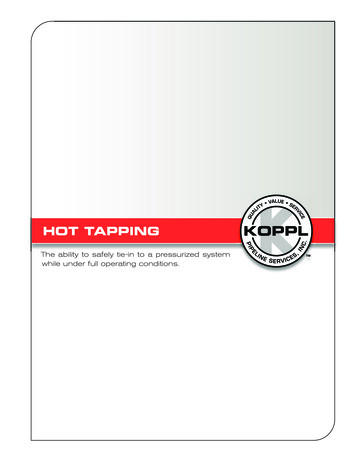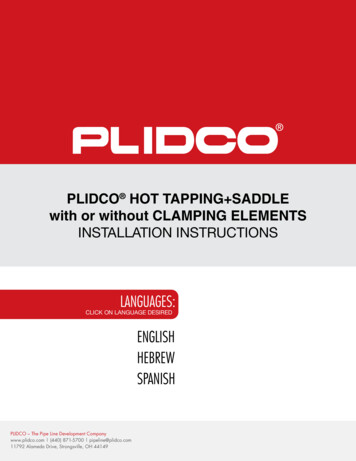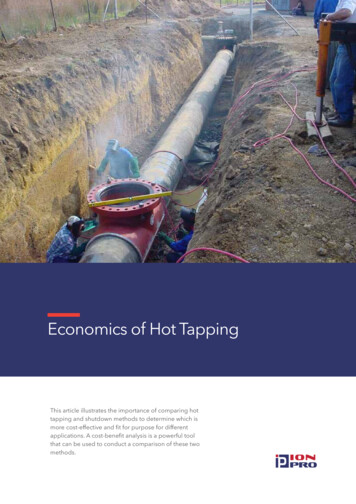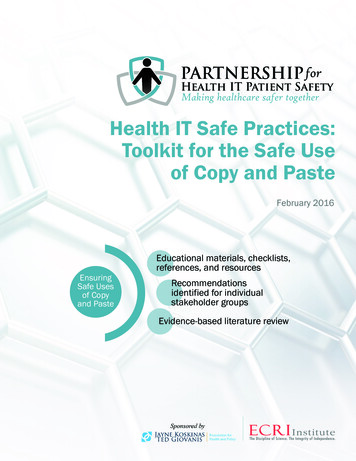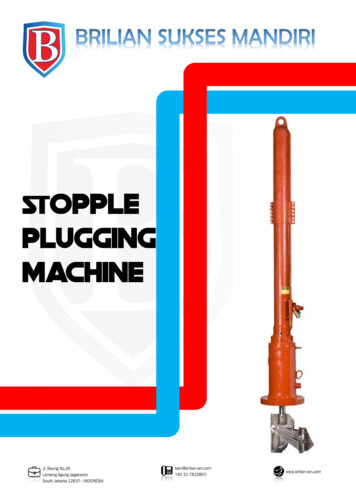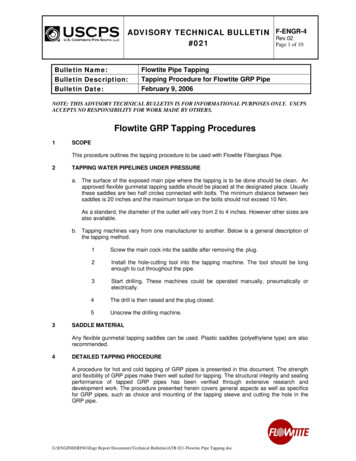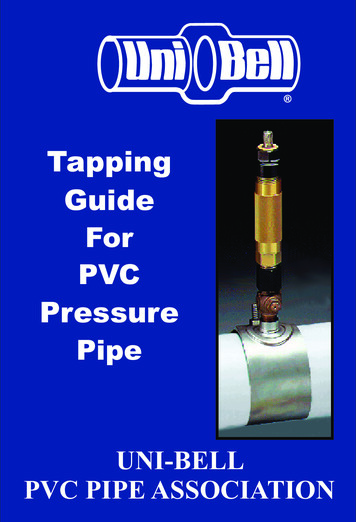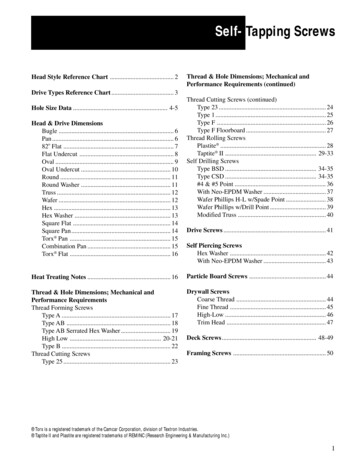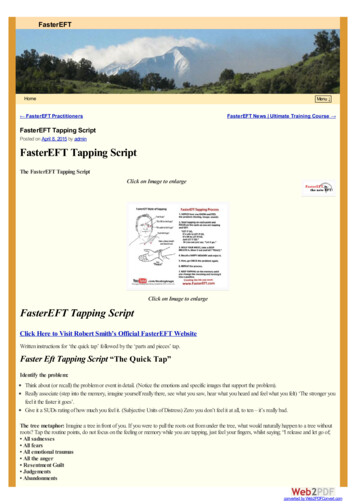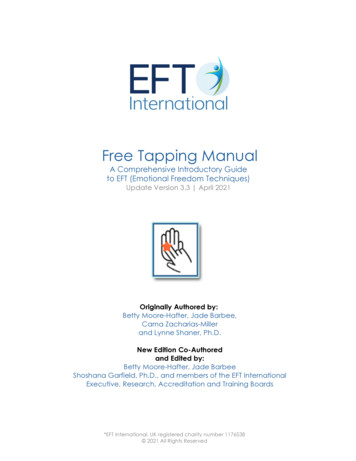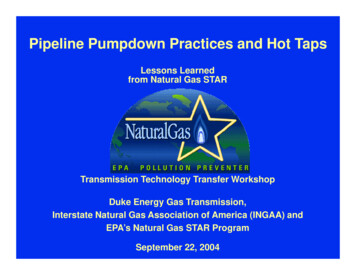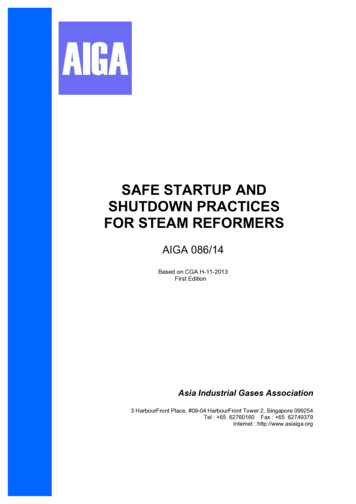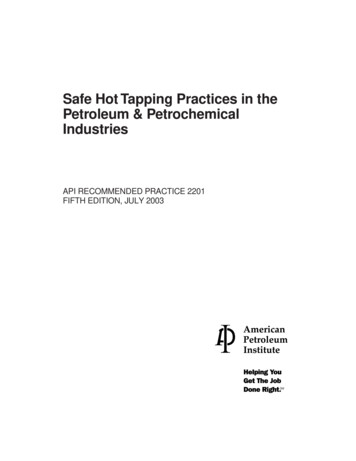
Transcription
Safe Hot Tapping Practices in thePetroleum & PetrochemicalIndustriesAPI RECOMMENDED PRACTICE 2201FIFTH EDITION, JULY 2003
Safe Hot Tapping Practices in thePetroleum & PetrochemicalIndustriesDownstream SegmentAPI RECOMMENDED PRACTICE 2201FIFTH EDITION, JULY 2003
SPECIAL NOTESAPI publications necessarily address problems of a general nature. With respect to particular circumstances, local, state, and federal laws and regulations should be reviewed.API is not undertaking to meet the duties of employers, manufacturers, or suppliers towarn and properly train and equip their employees, and others exposed, concerning healthand safety risks and precautions, nor undertaking their obligations under local, state, or federal laws.Information concerning safety and health risks and proper precautions with respect to particular materials and conditions should be obtained from the employer, the manufacturer orsupplier of that material, or the material safety data sheet.Nothing contained in any API publication is to be construed as granting any right, byimplication or otherwise, for the manufacture, sale, or use of any method, apparatus, or product covered by letters patent. Neither should anything contained in the publication be construed as insuring anyone against liability for infringement of letters patent.Generally, API standards are reviewed and revised, reaffirmed, or withdrawn at least everyfive years. Sometimes a one-time extension of up to two years will be added to this reviewcycle. This publication will no longer be in effect five years after its publication date as anoperative API standard or, where an extension has been granted, upon republication. Statusof the publication can be ascertained from the API Standards Department [telephone (202)682-8000]. A catalog of API publications and materials is published annually and updatedquarterly by API, 1220 L Street, N.W., Washington, D.C. 20005, www.api.org.This document was produced under API standardization procedures that ensure appropriate notification and participation in the developmental process and is designated as an APIstandard. Questions concerning the interpretation of the content of this standard or comments and questions concerning the procedures under which this standard was developedshould be directed in writing to the Director, Standardization, American Petroleum Institute,1220 L Street, N.W., Washington, D.C. 20005, standards@api.org. Requests for permissionto reproduce or translate all or any part of the material published herein should also beaddressed to the director.API standards are published to facilitate the broad availability of proven, sound engineering and operating practices. These standards are not intended to obviate the need for applying sound engineering judgment regarding when and where these standards should beutilized. The formulation and publication of API standards is not intended in any way toinhibit anyone from using any other practices.Any manufacturer marking equipment or materials in conformance with the markingrequirements of an API standard is solely responsible for complying with all the applicablerequirements of that standard. API does not represent, warrant, or guarantee that such products do in fact conform to the applicable API standard.All rights reserved. No part of this work may be reproduced, stored in a retrieval system, ortransmitted by any means, electronic, mechanical, photocopying, recording, or otherwise,without prior written permission from the publisher. Contact the Publisher,API Publishing Services, 1220 L Street, N.W., Washington, D.C. 20005.Copyright 2003 American Petroleum Institute
FOREWORDThis publication is designed to provide a better understanding of the problems and hazards encountered when installing hot tap connections on piping, vessels or tanks containingflammable or combustible liquids or gases. The essential elements of this publication arebased on accumulated knowledge and experience of the petroleum industry, current industrysafe operating practices, and existing consensus standards. The practices described in thispublication are designed to protect the safety of personnel and the facilities for the workinvolved. It shall be noted, however, that special problems beyond the scope of this publication are possible. Also, federal, state and local regulations or laws may contain additionalrequirements that must be taken into account when a hot tap program is developed for a specific facility.API publications may be used by anyone desiring to do so. Every effort has been made bythe Institute to assure the accuracy and reliability of the data contained in them; however, theInstitute makes no representation, warranty, or guarantee in connection with this publicationand hereby expressly disclaims any liability or responsibility for loss or damage resultingfrom its use or for the violation of any federal, state, or municipal regulation with which thispublication may conflict.Suggested revisions are invited and should be submitted to the Director, Standardization,American Petroleum Institute, 1220 L Street, N.W., Washington, D.C. 20005.INFORMATION CONCERNING SAFETY AND HEALTH HAZARDS AND PROPER PRECAUTIONS WITH RESPECT TO PARTICULAR MATERIALS AND CONDITIONS SHOULDBE OBTAINED FROM THE EMPLOYER, THE MANUFACTURER OR SUPPLIER OF THATMATERIAL, OR THE MATERIAL SAFETY DATA SHEET.iii
CONTENTSPage1GENERAL. . . . . . . . . . . . . . . . . . . . . . . . . . . . . . . . . . . . . . . . . . . . . . . . . . . . . . . . . . . .1.1 Purpose. . . . . . . . . . . . . . . . . . . . . . . . . . . . . . . . . . . . . . . . . . . . . . . . . . . . . . . . . .1.2 Scope . . . . . . . . . . . . . . . . . . . . . . . . . . . . . . . . . . . . . . . . . . . . . . . . . . . . . . . . . . .1.3 Retroactivity. . . . . . . . . . . . . . . . . . . . . . . . . . . . . . . . . . . . . . . . . . . . . . . . . . . . . .1.4 Concept of Hazard vs. Risk . . . . . . . . . . . . . . . . . . . . . . . . . . . . . . . . . . . . . . . . . .1.5 Concept of Competent and Qualified Persons . . . . . . . . . . . . . . . . . . . . . . . . . . .2REFERENCED PUBLICATIONS . . . . . . . . . . . . . . . . . . . . . . . . . . . . . . . . . . . . . . . . . 23DEFINITIONS. . . . . . . . . . . . . . . . . . . . . . . . . . . . . . . . . . . . . . . . . . . . . . . . . . . . . . . . . 34JOB ANALYSIS . . . . . . . . . . . . . . . . . . . . . . . . . . . . . . . . . . . . . . . . . . . . . . . . . . . . . .4.1 Job Analysis . . . . . . . . . . . . . . . . . . . . . . . . . . . . . . . . . . . . . . . . . . . . . . . . . . . . . .4.2 Reviewing Whether Hot Tapping is Appropriate . . . . . . . . . . . . . . . . . . . . . . . . .4.3 Job-specific Hot Tapping Review for Work Authorization . . . . . . . . . . . . . . . . . .5HAZARD EVALUATION AND RISK REDUCTION FORHOT TAPPING ON IN-SERVICE EQUIPMENT . . . . . . . . . . . . . . . . . . . . . . . . . . . . 95.1 General . . . . . . . . . . . . . . . . . . . . . . . . . . . . . . . . . . . . . . . . . . . . . . . . . . . . . . . . . . 95.2 Hot Tapping Overview. . . . . . . . . . . . . . . . . . . . . . . . . . . . . . . . . . . . . . . . . . . . . . 95.3 Physical Hazards . . . . . . . . . . . . . . . . . . . . . . . . . . . . . . . . . . . . . . . . . . . . . . . . . . 95.4 Thermal Burn Hazards to Personnel and Risk Reduction . . . . . . . . . . . . . . . . . . 95.5 Potential Acute Health Hazards and Risk Reduction . . . . . . . . . . . . . . . . . . . . . 105.6 Potential Chronic Health Hazards and Risk Reduction . . . . . . . . . . . . . . . . . . . 105.7 Flammable Liquids, Vapors, Solids, or Dusts . . . . . . . . . . . . . . . . . . . . . . . . . . . 105.8 Combustible Materials and Risk Reduction . . . . . . . . . . . . . . . . . . . . . . . . . . . . 116WELDING AND HOT TAP METALLURGY CONSIDERATIONS . . . . . . . . . . . .6.1 General . . . . . . . . . . . . . . . . . . . . . . . . . . . . . . . . . . . . . . . . . . . . . . . . . . . . . . . . .6.2 Burn-through Prevention . . . . . . . . . . . . . . . . . . . . . . . . . . . . . . . . . . . . . . . . . . .6.3 Flow in Lines . . . . . . . . . . . . . . . . . . . . . . . . . . . . . . . . . . . . . . . . . . . . . . . . . . . .6.4 Metal Thickness . . . . . . . . . . . . . . . . . . . . . . . . . . . . . . . . . . . . . . . . . . . . . . . . . .6.5 Fittings . . . . . . . . . . . . . . . . . . . . . . . . . . . . . . . . . . . . . . . . . . . . . . . . . . . . . . . . .6.6 Post Weld Heat Treatment (PWHT) . . . . . . . . . . . . . . . . . . . . . . . . . . . . . . . . . .6.7 Metal Temperature . . . . . . . . . . . . . . . . . . . . . . . . . . . . . . . . . . . . . . . . . . . . . . . .6.8 Welding and Hot Tap Connection Design . . . . . . . . . . . . . . . . . . . . . . . . . . . . . .6.9 Hot Tapping Equipment under Vacuum . . . . . . . . . . . . . . . . . . . . . . . . . . . . . . .6.10 Piping and Equipment Contents . . . . . . . . . . . . . . . . . . . . . . . . . . . . . . . . . . . . .7HOT TAPPING MACHINES. . . . . . . . . . . . . . . . . . . . . . . . . . . . . . . . . . . . . . . . . . . . 137.1 General . . . . . . . . . . . . . . . . . . . . . . . . . . . . . . . . . . . . . . . . . . . . . . . . . . . . . . . . . 137.2 Hot Tapping Machine Considerations . . . . . . . . . . . . . . . . . . . . . . . . . . . . . . . . . 148PREPARATIONS . . . . . . . . . . . . . . . . . . . . . . . . . . . . . . . . . . . . . . . . . . . . . . . . . . . . .8.1 Written Plans . . . . . . . . . . . . . . . . . . . . . . . . . . . . . . . . . . . . . . . . . . . . . . . . . . . .8.2 Management of Change. . . . . . . . . . . . . . . . . . . . . . . . . . . . . . . . . . . . . . . . . . . .8.3 Personnel Competency and Qualifications . . . . . . . . . . . . . . . . . . . . . . . . . . . . .v1111115555111111111212121212131315151515
Page9SPECIAL CONDITIONS . . . . . . . . . . . . . . . . . . . . . . . . . . . . . . . . . . . . . . . . . . . . . . .9.1 Hot Tapping and Welding on Tanks or Vessels . . . . . . . . . . . . . . . . . . . . . . . . . .9.2 Welding or Hot Tapping on the Decks of Floating Roof Tanks is Prohibited . .9.3 Welding or Hot Tapping Above or Below Grade . . . . . . . . . . . . . . . . . . . . . . . .9.4 Welding or Hot Tapping on Lined Piping, Lined Equipment or Cased Lines . .9.5 Hot Tapping on Piping . . . . . . . . . . . . . . . . . . . . . . . . . . . . . . . . . . . . . . . . . . . . .9.6 Hot Tapping Upstream of Equipment and Valves . . . . . . . . . . . . . . . . . . . . . . . .1515161616161610 HOT TAP OPERATIONS . . . . . . . . . . . . . . . . . . . . . . . . . . . . . . . . . . . . . . . . . . . . . .10.1 Preliminary Requirements . . . . . . . . . . . . . . . . . . . . . . . . . . . . . . . . . . . . . . . . . .10.2 Welding in Preparation for Hot Tapping . . . . . . . . . . . . . . . . . . . . . . . . . . . . . . .10.3 Inspecting the Weld . . . . . . . . . . . . . . . . . . . . . . . . . . . . . . . . . . . . . . . . . . . . . . .10.4 Installing the Hot Tapping Machine . . . . . . . . . . . . . . . . . . . . . . . . . . . . . . . . . .10.5 Testing the Weld and Hot Tapping Machine . . . . . . . . . . . . . . . . . . . . . . . . . . . .10.6 Completion. . . . . . . . . . . . . . . . . . . . . . . . . . . . . . . . . . . . . . . . . . . . . . . . . . . . . .16161717171718APPENDIX AAPPENDIX BAPPENDIX C1923APPENDIX DEXAMPLE HOT TAP CHECKLISTS . . . . . . . . . . . . . . . . . . . . . . . . . .EXAMPLE HOT TAPPING REQUEST FORMS . . . . . . . . . . . . . . . . .EXAMPLE OF WELDERS INSTRUCTIONS PRIORTO HOT TAPPING . . . . . . . . . . . . . . . . . . . . . . . . . . . . . . . . . . . . . . . . .EXAMPLE IN-SERVICE HOT TAP EMERGENCYACTION PLAN . . . . . . . . . . . . . . . . . . . . . . . . . . . . . . . . . . . . . . . . . . . .2527Figures1234Typical Hot Tap Activity Flow . . . . . . . . . . . . . . . . . . . . . . . . . . . . . . . . . . . . . . . . . 6Example Process to Review Whether Hot Tapping is Appropriate . . . . . . . . . . . . . 7Example Decision Process for Authorizing Hot Tapping . . . . . . . . . . . . . . . . . . . . 8Hot Tapping Machine and Typical Hot Tap Connection . . . . . . . . . . . . . . . . . . . . 14Tables123456Before Starting the Hot Tap . . . . . . . . . . . . . . . . . . . . . . . . . . . . . . . . . . . . . . . . . .Example of Fire Watch Duties . . . . . . . . . . . . . . . . . . . . . . . . . . . . . . . . . . . . . . . .Before Welding . . . . . . . . . . . . . . . . . . . . . . . . . . . . . . . . . . . . . . . . . . . . . . . . . . . .Before Cutting . . . . . . . . . . . . . . . . . . . . . . . . . . . . . . . . . . . . . . . . . . . . . . . . . . . . .Before Removing the Hot Tapping Machine . . . . . . . . . . . . . . . . . . . . . . . . . . . . .After Removing the Hot Tapping Machine . . . . . . . . . . . . . . . . . . . . . . . . . . . . . .vi192020202021
Safe Hot Tapping Practices in the Petroleum & Petrochemical IndustriesSECTION 1—GENERAL1.1 PURPOSEresponse to unique job specific problems or situations thatmay arise concerning the safety of personnel and facilities.The hot tap approach described in this publication appliesto piping and equipment fabricated from ferritic and austenitic steel. Other materials, such as aluminum, copper, plastic,and cast iron may be unsuitable for hot tapping or welding ormay require special procedures.Hot tapping is a “change” subject to review based on facility “management of change” processes or procedures.This publication provides information to assist in safelyconducting hot tapping operations on equipment in service inthe petroleum and petrochemical industries. No documentcan address all situations nor answer all potential questions.However, the understanding of potential hazards, and application of this knowledge, can help reduce the probability andseverity of incidents.1.2 SCOPE1.3 RETROACTIVITYHot tapping is the technique of attaching a welded branchfitting to piping or equipment in service, and then creatin
Hot tapping is the technique of attaching a welded branch fitting to piping or equipment in service, and then creating an opening in that piping or equipment by drilling or cutting a
